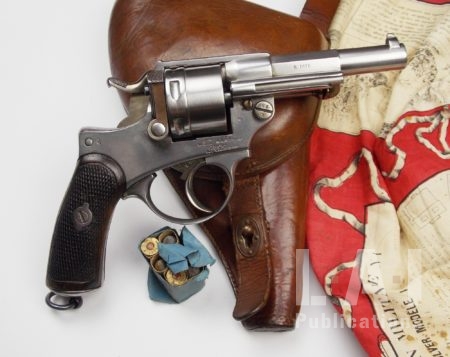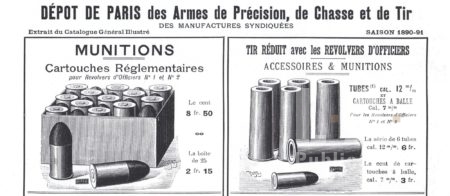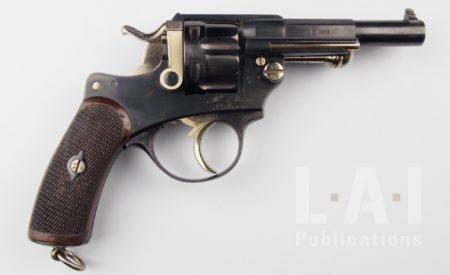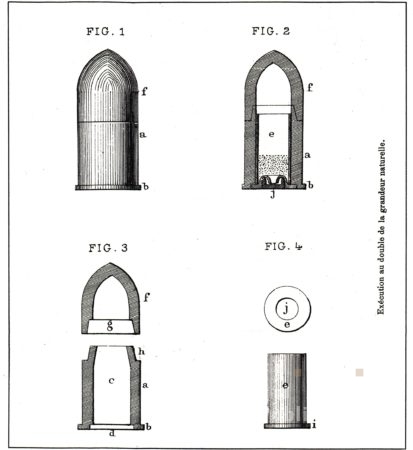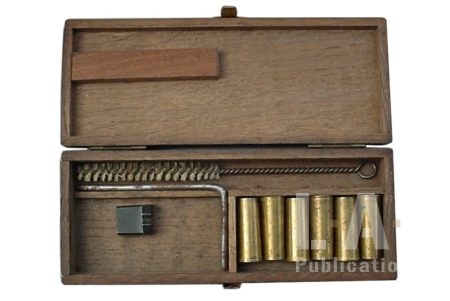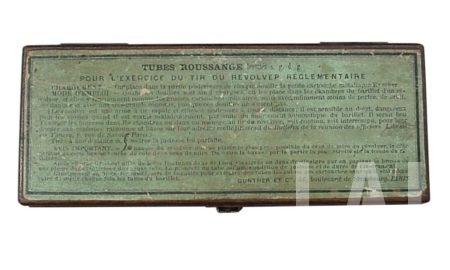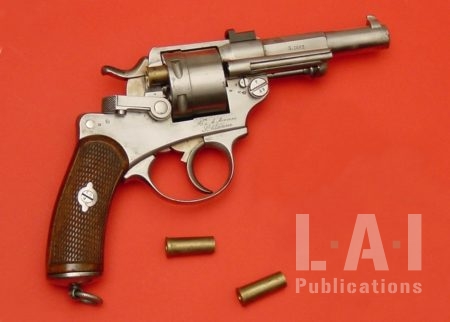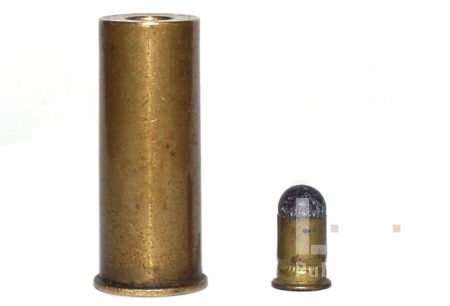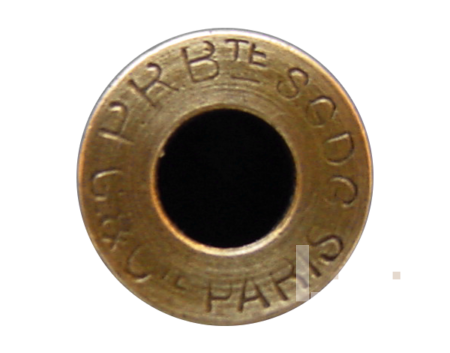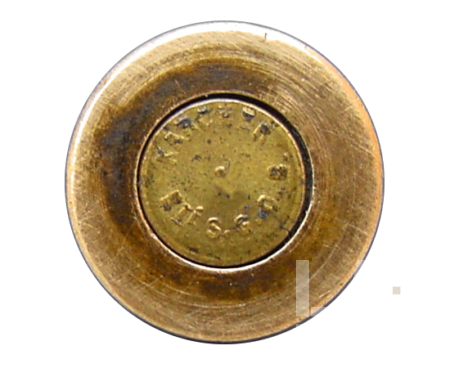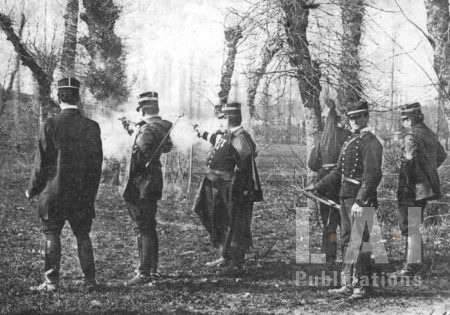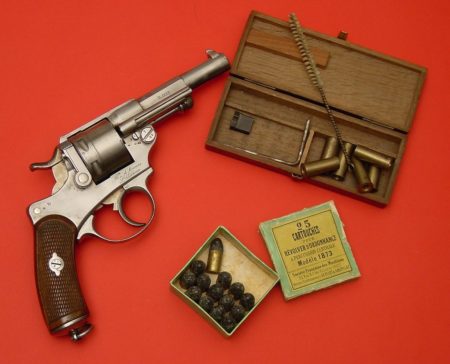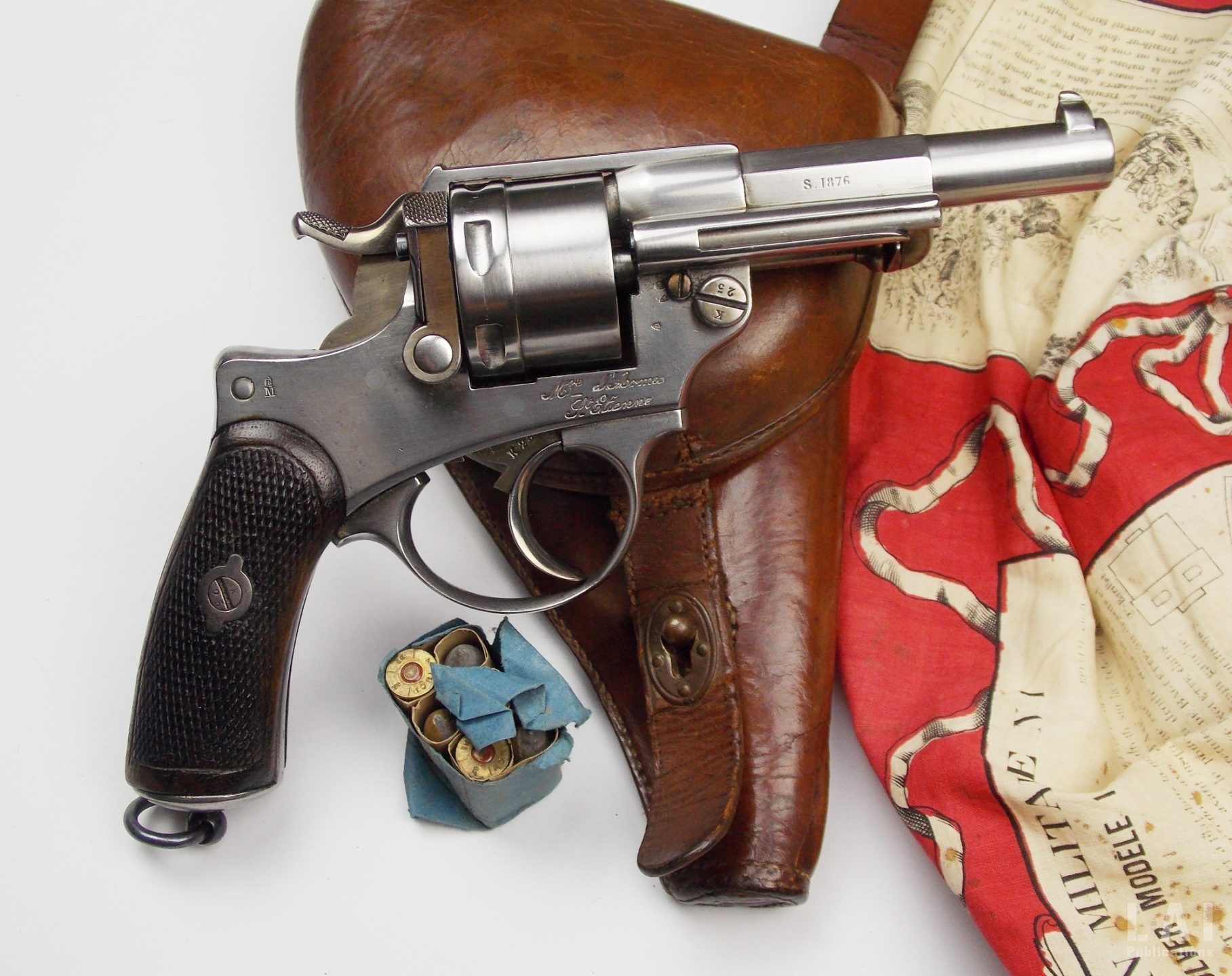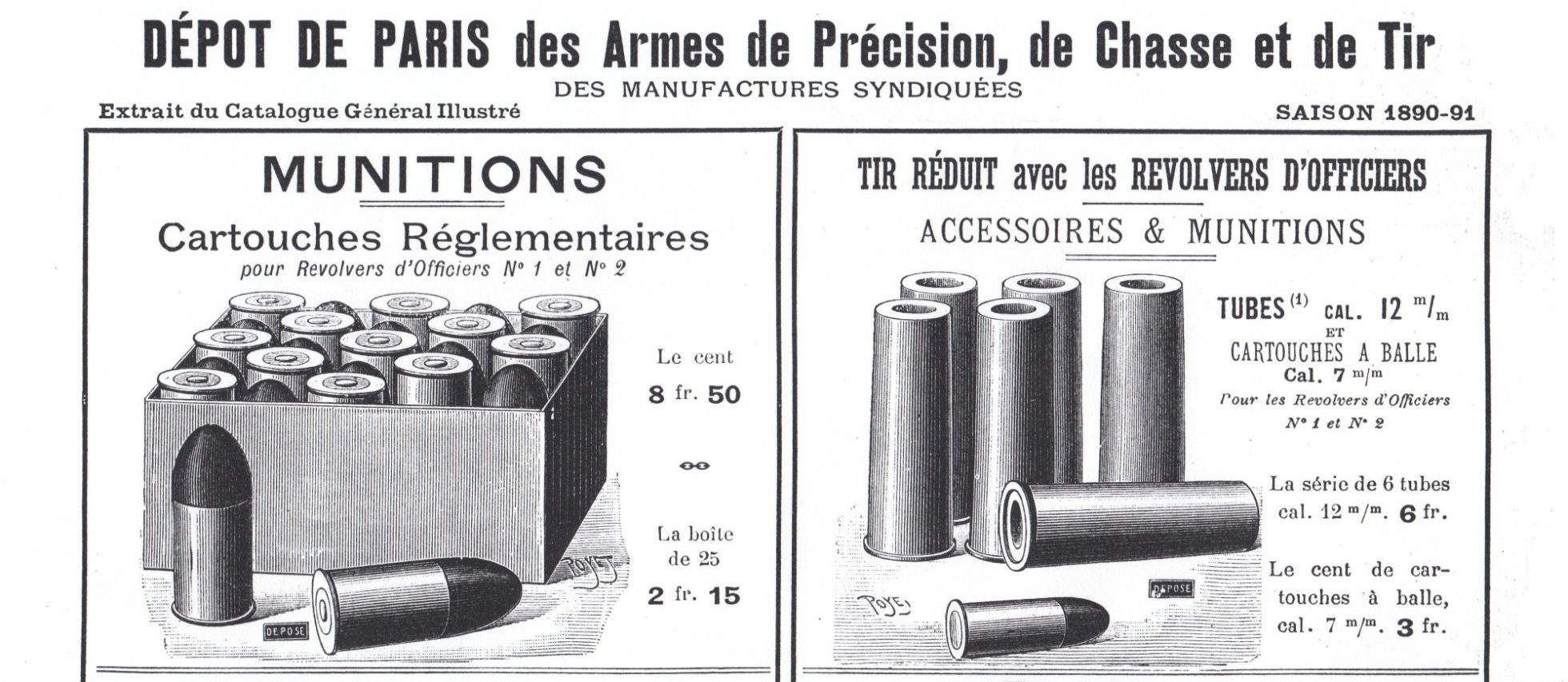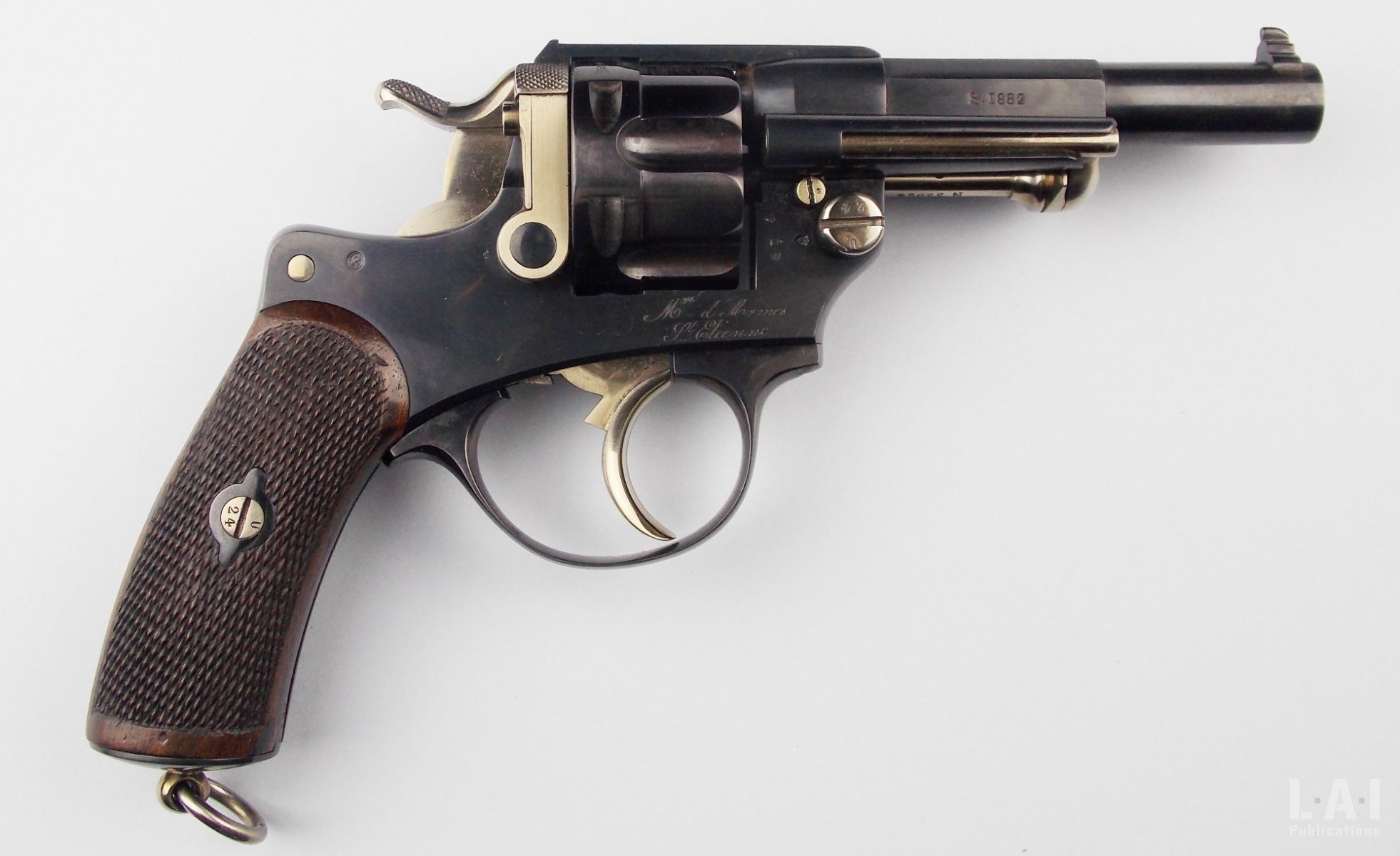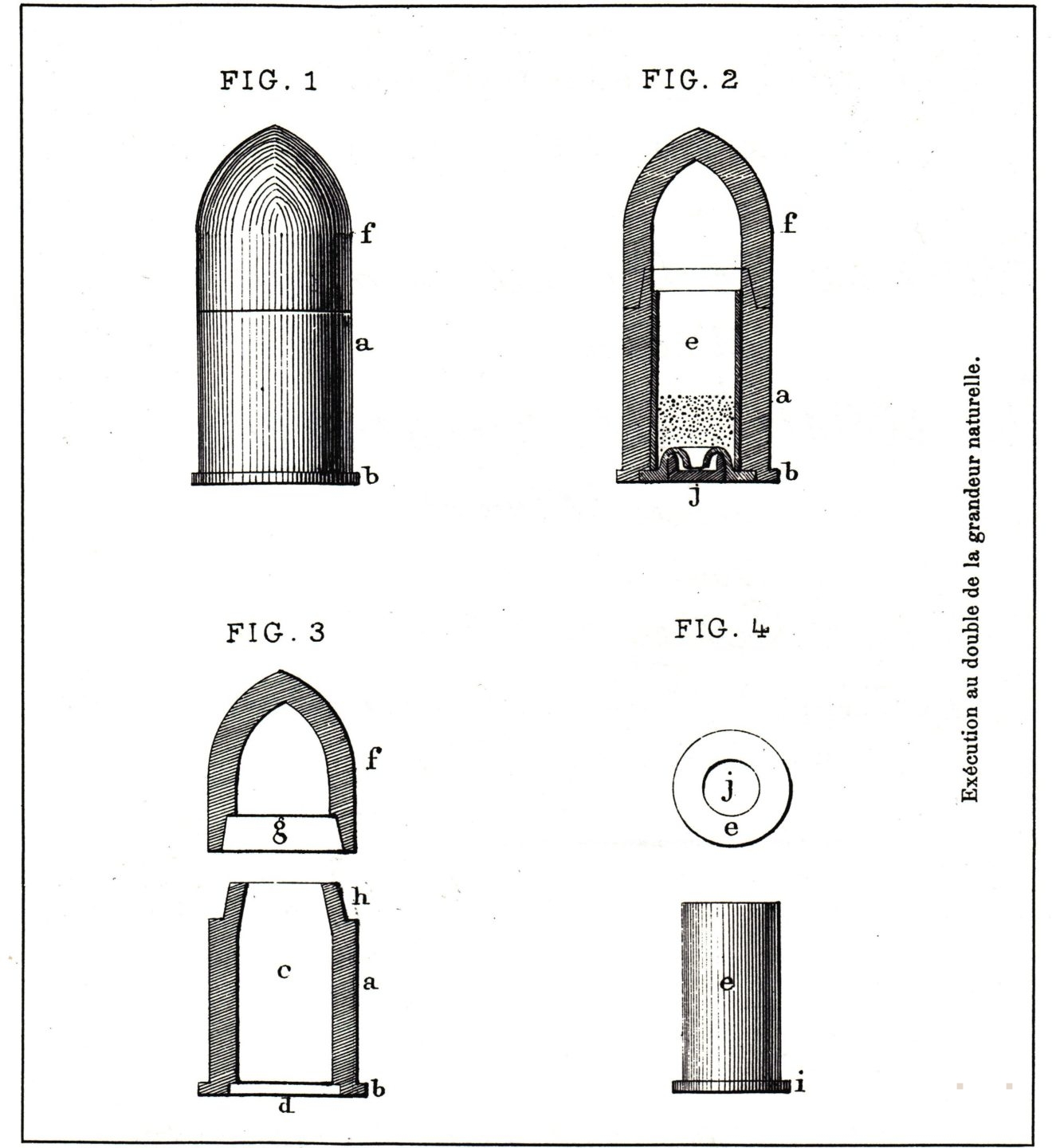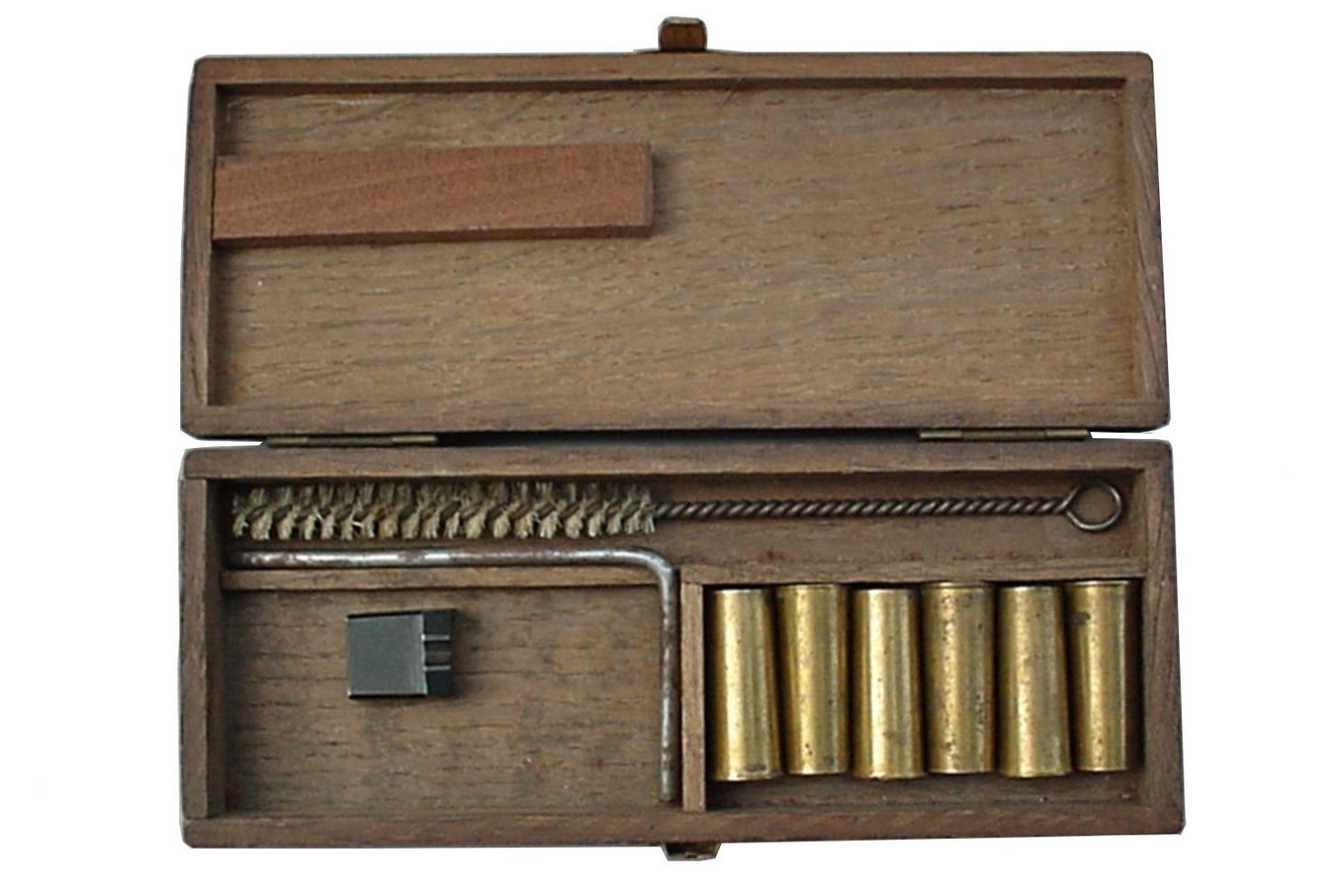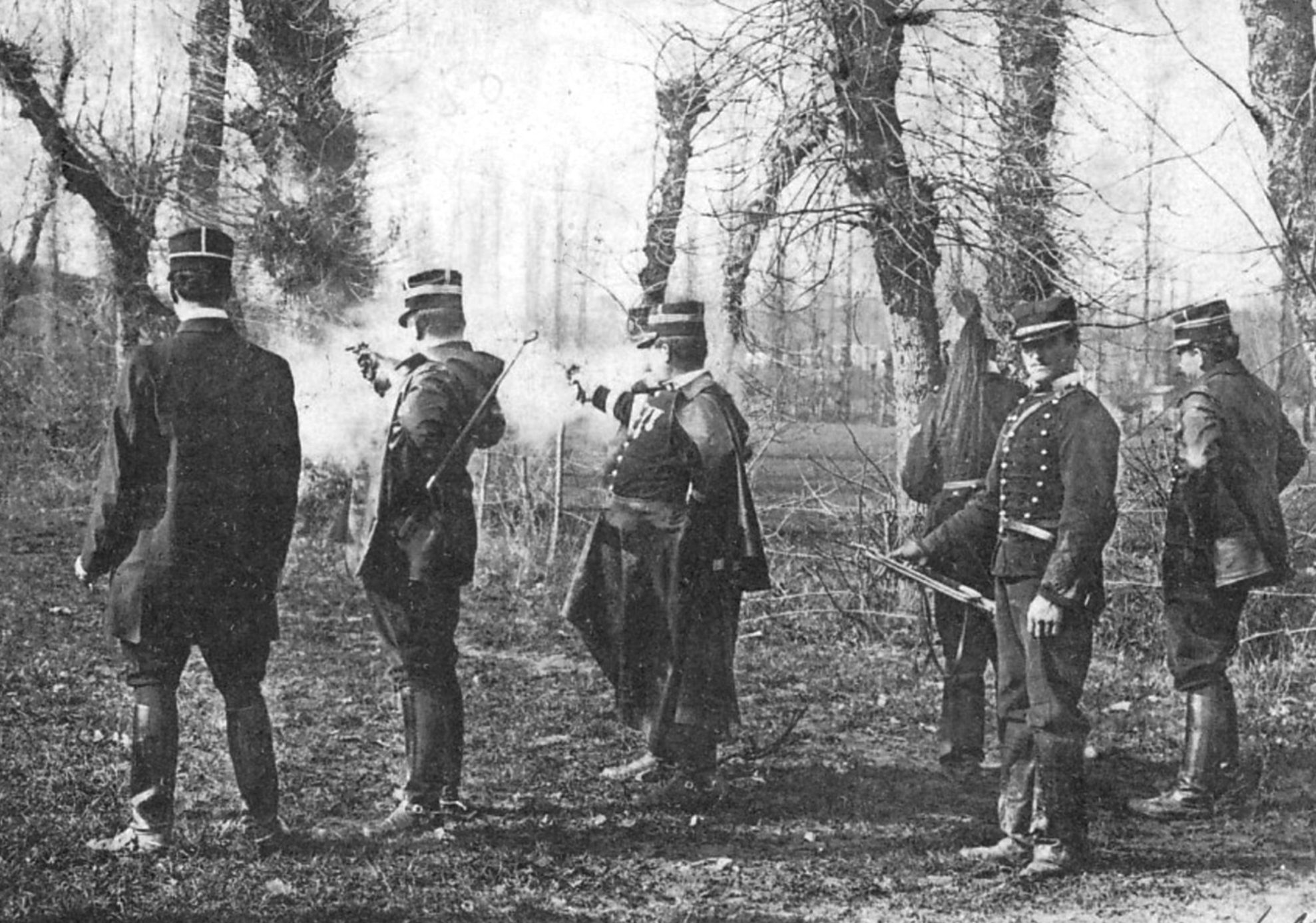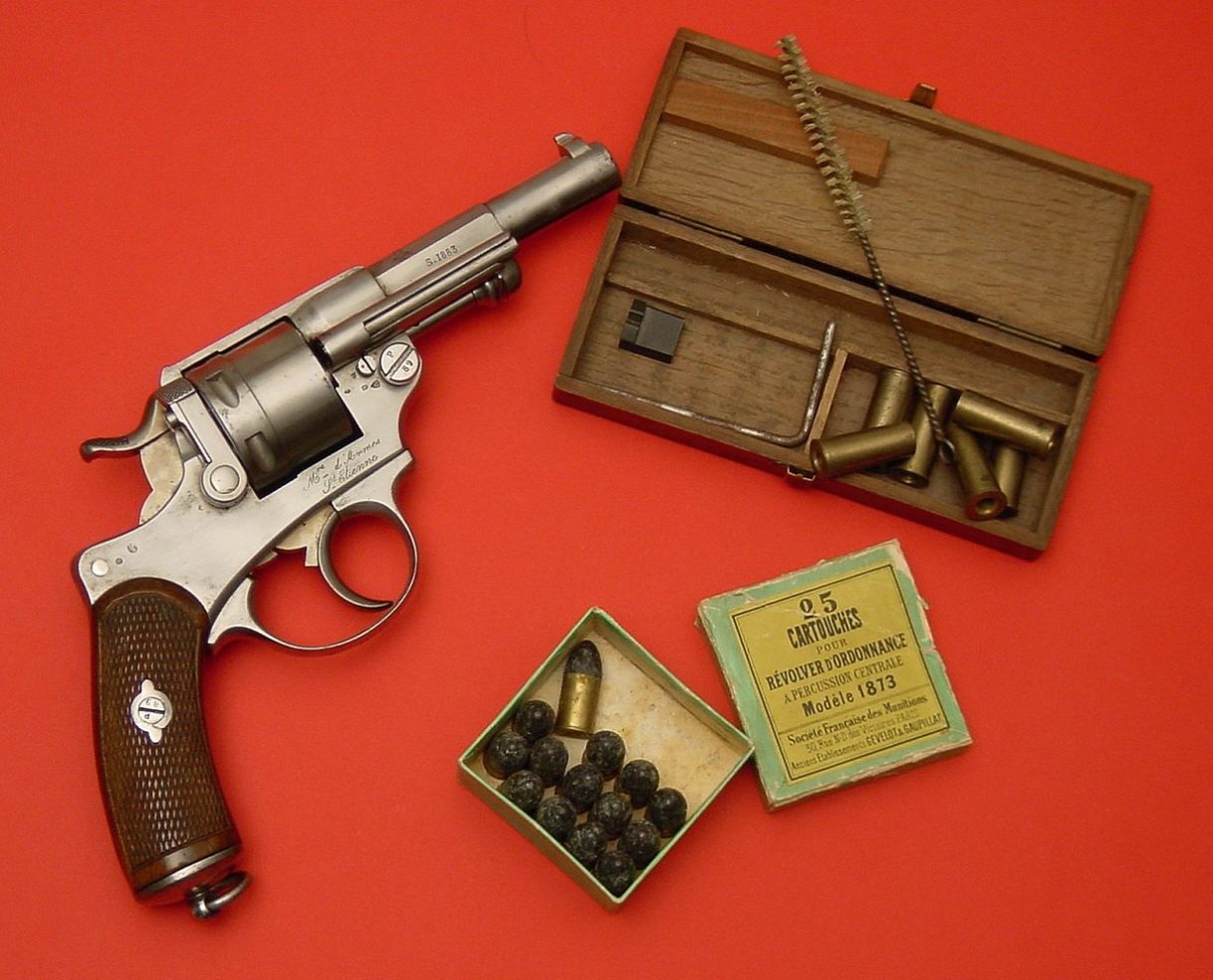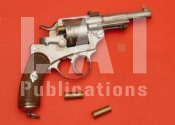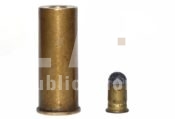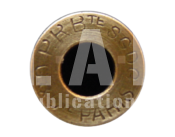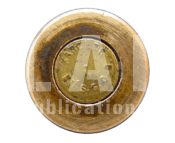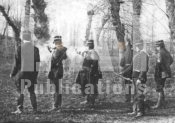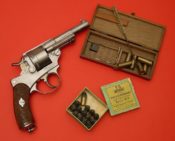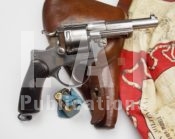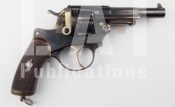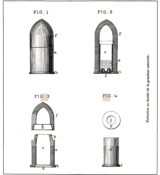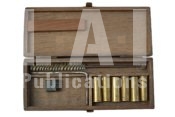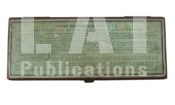The short-range training cartridge for the French Model 1873 revolver

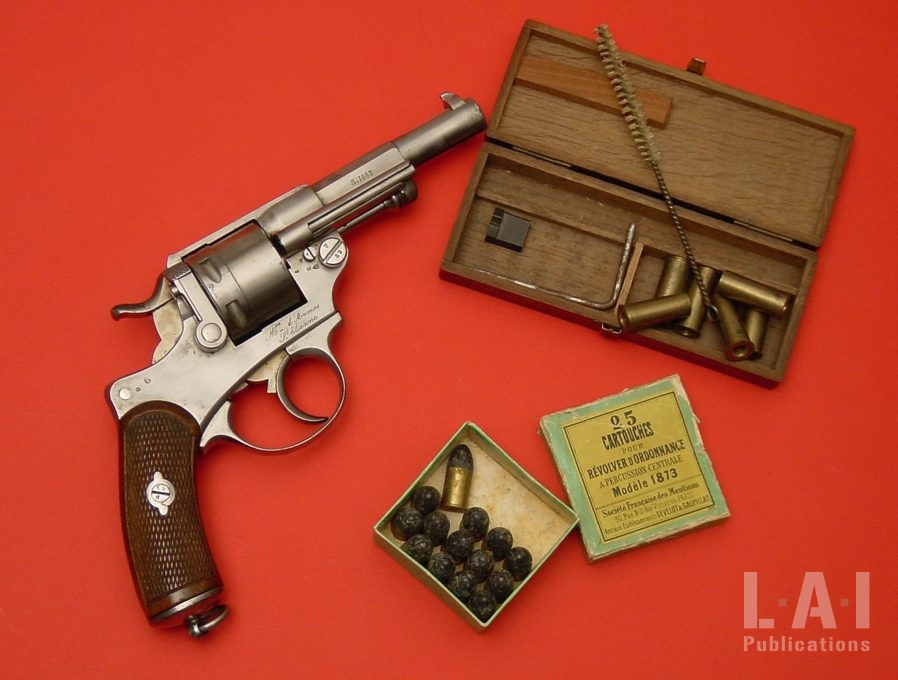
As soon as it was adopted by the Gendarmerie and then by the French army, the Mod. 1873 revolver developed from the work of Chamelot and Delvigne met with great success.
The military used it in large quantities, but the weapon also seduced an informed public that brought together police, colonials and sports shooters. From 1875 to 1890, several short-range training systems were created. They aimed to reduce the cost of ammunition used for training. Pattey,Lee & Cie, successors of the famous Amédée Maquaire from the direction of the “Dépôt de Paris”, were the first to disseminate an economic system of short-range training to the service revolver. Their system consists of a conical bullet cartridge, intended for service revolvers and war rifles. Their case is made of brass. It is at the outer dimensions of the service cartridge, hollow and reduced at the neck. It is capped by a light lead bullet that passes over the neck. The bullet is propelled by a small cartridge with a reduced charge, inserted from the rear into the adaptor chambered by the weapon of war. This device, which was not widespread at the time, seems to have been distributed only by the “Dépôt de Paris des armes de chasse et de tir des Manufactures Syndiquées”. A similar device would be available in the catalog of the Société Française de Munitions (SFM) a few years later. But with a straight case this time, without a reduced neck, and a lighter bullet that engages in the case instead of capping it.
Older and much more widespread, the Roussange system is just as interesting.
The Colonel Roussange
Étienne Paul Roussange was born on March 28th, 1838, in Saint-Junien, Haute-Vienne in France. He joined the army on his own in the 5th Dragoon in Limoges in April 1855, was appointed Brigadier on June 17th, 1856, he was then sent to the school of Saumur as a student-instructor. Appointed “Maréchal des Logis” (Sergeant) at the end of the first year of the course, he then obtained a good ranking which entitled him to an automatic nomination to the rank of Second Lieutenant. Second Lieutenant in December 1861, and placed in the 10th Dragoons, Roussange followed, in 1863-1864, the course of the sub-lieutenants, in Saumur, and finished second in a class of forty-five students, which allowed him to access automatically to the higher rank. In Limoges (center of France), in 1869, his leg was fractured by a bad horse kick. The accident failed to cost him his career, but he recovered, and he made the campaign of 1870 with a limp. His regiment was taken at Sedan. He was imprisoned and directed to Magdeburg where he remained until the end of the war of 1870. Appointed Captain on July 26th, 1872, he followed in 1873 the shooting lessons of Vincennes and was then assigned to the Gendarmerie. He began in his new corps at the Alençon depot, as a permanent “Buyer Captain” and was appointed Captain of the Gendarmerie on February 20th, 1874. For nearly eight years, Étienne Paul Roussange made many ruinous attempts to have the new instruments of reduced fire that he had invented adopted. In 1883, he was Squadron Leader and successively commanded the companies of the departments of Lot et Garonne and Creuse. Promoted to Lieutenant-Colonel in November 1891 he was designated to command the “17th Légion bis”, he then left for Limoges where he took command of the 12th Légion in 1894.
A short-range training system
It was during his time in Alençon that he patented, on May 1st, 1875, his adaptor system called in French “système de douille-tube” (TN: case-tube system) intended for the training fire of service weapons. The reducing tubes he created for the service 11-millimeter revolver are sold by six, along with a few accessories, in a small sheet metal box. Directions for use are written on the label. The patent, registered under No. 107413, describes an economic system, without noise and without recoil, consisting of bronze tubes equipped before firing with a small ball and a central percussion primer capsule.
When the army became interested in the Duranthon system, in 1876, for short range training to the model 1874 rifle, Roussange integrated into his own system the Karcher cartridge used by the commission that tested the Duranthon tube. The essence of this new device lies in the use of the same reducing tube in which is placed, this time, a small Karcher-type bullet cartridge in 5 mm caliber. The cases thus loaded are placed in the chambers of the cylinder of the service revolver. They work like service cartridges, but with a reduced range, less noise, recoil and much less smoke. The inventor announced a perfect accuracy at five meters and a substantial saving for the user since the adaptor can be used indefinitely.
Since Karcher’s ammunition does not have enough power to raise the barrel of the weapon, a small additional increase is used to correct the aim. It is placed, close to the rear sight, on the strip of the revolver. To remove the additional sight, at the end of the shot, it is slid on the strip, going from the hammer to the front sight. A small accessory, made of angled rod, comes with the set. It serves as a pusher and allows to extract the cases of the Karcher cartridges fired without it being necessary to take out each time the adaptor from the cylinder of the revolver.
The revolver short-range firing system uses two kinds of adaptor: a “long-range” adaptor and a “short-range” adaptor. The long-range adaptor has an external shape that fits the barrel chambers. The length of the adaptor for the officer’s revolver Mod. 1874 should not exceed 30 millimeters. The length of the adaptor for the troop revolver Mod. 1873 should not exceed 34 millimeters. This difference in length of the two adaptors corresponds to the difference in length of the two barrels, that of the officer’s revolver Mod. 1874 being shorter than that of the troop revolver Mod. 1873. The officer’s revolver adaptor can work in a troop revolver thanks to its shorter length. But the troop revolver’s adaptor is too long to work in an officer’s revolver. The long-range adaptor is rifled; it uses the same cartridge as the rifle’s rifled adaptor, but the inside caliber is a little weaker. The short-range adaptor differs from the previous adaptor only in the absence of rifling. The core is smooth, and it uses a small cartridge little dosed in powder and lead. At the distance of 5 meters the shot is perfect, at 10 meters it is still good, but beyond 10 meters the short-range adaptor shot is more or less good depending on the address of the shooter. From 10 meters the ball quickly loses its strength. This short-range system has the advantage of being even more economical than the previous one, and of allowing shooting without leaving home: “We recommend it very seriously to all shooters wishing to learn to shoot with the left hand for the following reasons:
1° The cartridge makes less noise,
2° The weapon has no climbing,
3 °The shaking given to the wrist is almost insensitive. »
If the manual is to be believed, eight days of exercises are enough for a shooter to become ambidextrous, and this only practical side of short-range shooting system, says the inventor “would justify the usefulness of the short-range training system to the revolver, because a soldier must be able to make good use of his revolver with any hand”.
Before firing, it is recommended to slightly oil inside the adaptors, especially for rifled adaptors. For the duration of a shooting session, the tubes never fouled enough to influence the shot, regardless of the number of cartridges fired; but as soon as you stop shooting it is essential to wipe the adaptors clean. They are cleaned with the help of an oiled brush run through the adaptor, then wiping it with a cloth. In the absence of ordinary oil “one can use petroleum, or pure vinegar, but ordinary oil is preferable to keep the rifling polish that facilitates the regular sliding of the ball”.
Karcher cartridges
Filed, just a few weeks before Roussanges’, the patent that protected the ammunition used in the adaptors is due to the mechanic Paul Karcher. In his patent, dating from February 17th, 1875, he described in detail a new type of economic ammunition consisting of a thin brass case stamped with a rather rustic primer, made of fulminate enclosed between two paper discs; an anvil held in place by an external knurling, which deeply marks the case; a little black powder and a round or ogival ball according to the uses. These cartridges, produced in various calibers, are mainly used in 5 mm caliber in adaptor cartridges intended for handguns, but some catalogs of gunsmiths, including that of Amédée Maquaire in Paris, report short-range system firing in 7 mm caliber.
Shooting in room and reduced prices
The small adaptor case for an officer’s or troop’s revolver includes:
- Six smooth or rifled adaptors (the length varies depending on the model);
- An iron angled extractor-rod;
- Two rear sights, white and black;
- A brush to clean the adaptors;
- A wool cloth to compress the boxed adaptors;
- An explanatory note.
At the end of the 19th century, we find retailed prices for the complete box or the elements necessary to replace the parts used. Some examples of these prices:
| A box of Roussange adaptors for officer or troop revolver, smooth core, ordinary bronze, round bullet | 6 francs |
| A box of Roussange adaptors, perfected, for officer or troop revolver, selected bronze rifled, long bullet | 8 francs |
| A box of one hundred Karcher cartridges, round bullet | 2 francs |
| A box of one hundred Karcher cartridges, long bullet. | 2.50 francs |
| A box of fifty flare cartridges | 2.50 francs |
| A box of fifty cartridges for powder fires | 1.25 francs |
| An angled extractor with brass ring, in addition to the one contained in each rifle adaptor box | 0.50 francs |
Jean-Pierre Bastié
This is free access work: the only way to support us is to share this content and subscribe. In addition to a full access to our production, subscription is a wonderful way to support our approach, from enthusiasts to enthusiasts!


